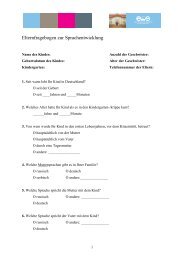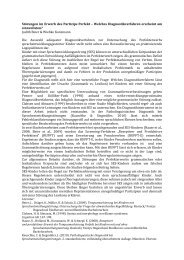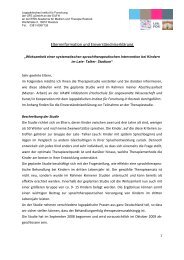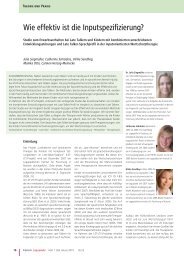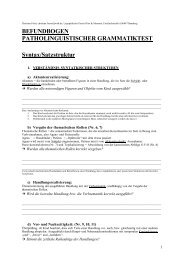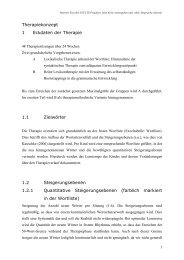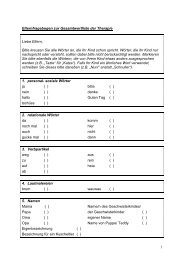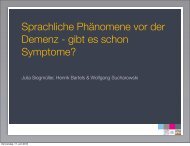mutual exclusivity constraint - Opus - KOBV
mutual exclusivity constraint - Opus - KOBV
mutual exclusivity constraint - Opus - KOBV
Erfolgreiche ePaper selbst erstellen
Machen Sie aus Ihren PDF Publikationen ein blätterbares Flipbook mit unserer einzigartigen Google optimierten e-Paper Software.
Masataka, N. 2000. Information from speech and gesture is integrated when meanings of new words<br />
are categorized in normal children but not in children with Williams syndrome. Cognitive<br />
Studies, 7: 37-51.<br />
Masataka, N. 2001. Why early linguistic milestones are delayed in children with Williams syndrome:<br />
late onset of hand banging as a possible rate-limiting <strong>constraint</strong> on the emergence of canonical<br />
babbling. Developmental Science 4: 158-164.<br />
Meng, X., Lu, X., Li, Z., Green, E. D., Massa, H., Trask, B. J., Morris, C. A., & Keating, M. 1998.<br />
Complete physical map of the common deletion region in Williams syndrome and<br />
identification and characterization of three novel genes. Human Genetics, 103: 590-599.<br />
Merriman, W. E. & Schuster, J. M. 1991. Young children´s disambiguation of object name reference.<br />
Child Development, 62: 1288-1301.<br />
Mervis, C. & Bertrand, J. 1994. Acquisition of the novel name-nameless category (N3C) principle.<br />
Child Development, 65: 1646-1663.<br />
Mervis, C. & Bertrand, J. 1995. Early lexical development of children with Williams syndrome.<br />
Genetic Counselling, Spec. Issue 6: 134.<br />
Mervis, C. & Bertrand, J. 1997. Developmental relations between cognition and language. In<br />
Adamson, L. B. & Romski, M. A. (Eds.), Communication and language acquisition. Baltimore,<br />
Paul Brooks Publ.: 75-106.<br />
Mervis, C., Morris, C. A., Bertrand, J., & Robinson, B. F. 1999. Williams syndrome: findings from an<br />
integrated program of research. In Tager-Flusberg, H. (Ed.), Neurodevelopmental disorders:<br />
contributions to a new framework from cognitive neuroscience. Cambridge, MIT Press: 65-110.<br />
Mervis, C., Robinson, B. F., Rowe, M. L., Becerra, A. M., & Klein-Tasman, B. P. 2004. Relations<br />
between language and cognition in Williams syndrome. In Bartke, S. & Siegmüller, J. (Eds.),<br />
Williams syndrome across languages. Amsterdam, John Benjamins Publishing Company: 63-<br />
92.<br />
Mervis, C. B. & Robinson, B. F. 2000. Expressive vocabulary ability of toddlers with Williams<br />
syndrome or Down syndrome: a comparison. Developmental Neuropsychology, 17: 11-126.<br />
Metsala, J. L. 1997. An examination of word frequency and neighbourhood density in the development<br />
of spoken word recognition. Memory & Cognition, 25: 47-56.<br />
Meyer-Lindenberg, A., Mervis, C., & Faith Berman, K. 2006. Neural mechanisms in Williams<br />
syndrome: a unique window to genetic influences on cognition and behaviour. Nature Reviews<br />
Neuroscience, 7: 381-393.<br />
Morris, C. A., Demsey, S., Leonard, C., Dilts, C., & Blackburn, B. 1988. Natural history of Williams<br />
syndrome: physical characteristics. Journal of Paediatrics, 113: 318-326.<br />
Morris, C. A. & Mervis, C. 1999. Williams syndrome. In Goldstein, S. & Reynolds, C. R. (Eds.),<br />
Handbook of neurodevelopmental and genetic disorders. New York, London, The Guilford<br />
Press: 555-590.<br />
Morris, C. A., Pober, B., Wang, P. P., Levinson, M., Sadler, L., Kaplan, P., Lacro, R., & Greenberg, F.<br />
1999. Medical guidelines for Williams syndrome.<br />
Murphy, G. L. 2002. The big book of concepts. Cambridge, MA: Bradford Book, MIT.<br />
Nazzi, T., Paterson, S., & Karmiloff-Smith, A. 2003. Early word segmentation by infants and toddlers<br />
with Williams syndrome. Infancy, 4: 251-271.<br />
Novelli, A., Sabani, M., Caiola, A., Digilio, M. C., Giannotti, A., Mingarelli, R., Novelli, G., &<br />
Dallapiccola, B. 1999. Diagnosis of DiGeorge and Williams syndromes using FISH analysis of<br />
peripheral blood smears. Molecular and Cellular Probes, 13: 303-307.<br />
Pani, J. R., Mervis, C., & Robinson, B. F. 1999. Global spatial organization by individuals with<br />
Williams syndrome. Psychological Science, 10: 453-458.<br />
Pankau, R. 1999. Die genetische Ursache des Williams-Beuren-Syndroms. Vortrag, Kirchheim:<br />
Jahrestagung des Bundesverbandes Williams-Beuren-Syndroms, e.V.<br />
Pankau, R., Partsch, C., Gosch, A., Siebert, R., Schneider, M., Schneppenheim, R., Winter, M., &<br />
Wessel, A. 2000. Williams-Beuren syndrome 35 years after the diagnosis of the first Beuren<br />
patient. American Journal of Medical Genetics, 91: 322-324.<br />
Parish-Morris, J., Hennon, E., Hirsh-Pasek, K., Golinkoff, R., & Tager-Flusberg, H. 2007. Children<br />
with autism illuminate the role of social intention in word learning. Child Development, 78:<br />
1265-1287.<br />
Paterson, S., Brown, E., Gsödl, M., Johnson, M. H., & Karmiloff-Smith, A. 1999. Cognitive<br />
modularity and genetic disorders. Science, 286: 2355-2358.<br />
Penner, Z. 1999. Screeningverfahren zur Feststellung von Störungen in der Grammatik. Luzern: SZH.<br />
156







